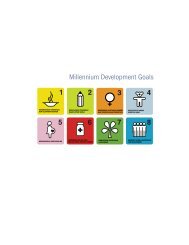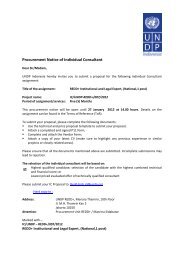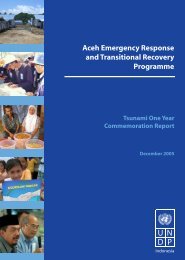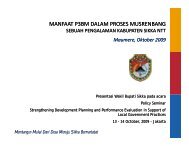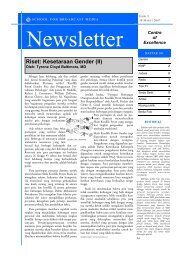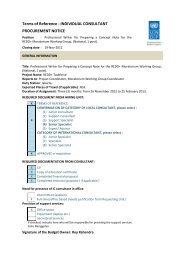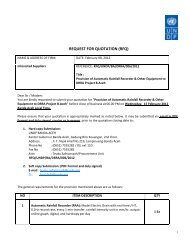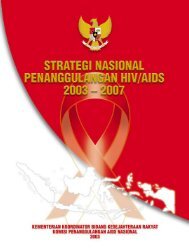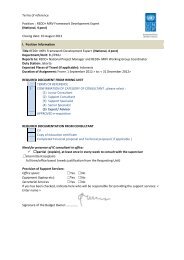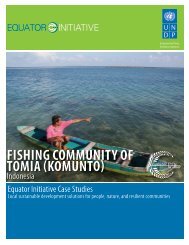Papua Needs Assessment - UNDP
Papua Needs Assessment - UNDP
Papua Needs Assessment - UNDP
You also want an ePaper? Increase the reach of your titles
YUMPU automatically turns print PDFs into web optimized ePapers that Google loves.
5.4 Basic and community infrastructure<br />
Although <strong>Papua</strong> is resource-rich, it is still poor in infrastructure. The lack of adequate infrastructure<br />
not only limits potential livelihood opportunities, it presents a serious bottleneck to improving<br />
community access to health and educational services as well as to communications with the<br />
government and outside markets. The <strong>Papua</strong>n geography is a major constraint in developing<br />
roads in the region. To date, the roads network that connects kabupatens and cities is still very<br />
limited. Priority artery roads in mountainous regions are not yet developed, while the roads built<br />
by the forest concessionaires are not accessible to the public. <strong>Papua</strong>’s access and transport<br />
challenges are arguable better addressed by sea and air.<br />
Indeed, many of the inland and mountain<br />
areas of <strong>Papua</strong> can only be reached using<br />
air transport. <strong>Papua</strong> has 4 internationalstandard<br />
airports (Sentani-Jayapura, Biak,<br />
Merauke, Timika), 59 domestic airports<br />
(including pioneer airports), and 297 airstrips<br />
that are managed by churches or<br />
community-based organisations. The major<br />
sea ports of the region connect the region<br />
to national and international commerce.<br />
There are deep-water port facilities at<br />
Sorong, Manokwari, Biak and Jayapura,<br />
from which commodities can be directly<br />
exported. Sea harbours are also the sole<br />
source of transport to the small islands of the region, coastal areas and by the major rivers. Sea<br />
transportation is relatively low cost compared to land and air transportation and thus plays a<br />
critical role in the economy of the region.<br />
While urban infrastructure is quite comparable with other regions of Indonesia, the situation outside<br />
these areas is notably lagging. Some kabupatens have no access to the main seaports or<br />
airports, and within the more remote kabupatens, people travel by foot, motorbike or canoes. In<br />
many of the new kabupatens there is no electricity, no telephone service and no public transport.<br />
Systems and facilities for waste management are scarce and ineffective. The facilities and the<br />
services in the new kabupatens are generally worse than in the older ones as they are more<br />
remote. A more important determinant in the quality of infrastructure is the distance from urban<br />
centres.<br />
Most of the government-funded infrastructure that <strong>Papua</strong>n villagers see has been built by external<br />
contractors with minimal genuine local involvement. Thus, the existing infrastructure in villages is<br />
subsequently rarely well maintained and in many cases it is not used. Contracting of communities<br />
for infrastructure development, with contractors used only for technical assistance to the<br />
communities, has not been part of government policy or practice to date. Having not been<br />
involved in its development, local people tend not to feel ownership of basic infrastructure that the<br />
government constructs. There are, however, other community assets that people construct,<br />
maintain, and use, including communal and adat houses, canoes, wells, and piers. Communitybuilt<br />
infrastructure such as roads or schools is rare, but where it exists its upkeep tends to be<br />
better. Churches exist in nearly all villages, are built by the community, and are generally well<br />
maintained.<br />
25



